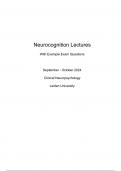Neurocognition Lectures
With Example Exam Questions
September - October 2024
Clinical Neuropsychology
Leiden University
,Lecture 1 → Development
● Brain structure & anatomy
○ Neuron anatomy
■ Cell body
■ Axon
■ Axon hillock
■ Dendrites
■ Synapse
■ Synaptic cleft
● Pre &
postsynaptic side
● Vesicles &
receptors
■ Myelin sheath
■ Nodes of Ranvier
○ Neuron types
■ Categorized by shape
and function
■ Sensory (afferent)
■ Interneurons (stellate, pyramidal, purkinje)
■ Motor (efferent)
○ Action potentials
■ Thresholded, non decremental, all-or-nothing response
■ Triggered by summation of excitatory potentials
■ Driven by varying permeability of cell membrane
■ Propagates along an axon, can travel for 1m or more
■ Triggers neurotransmitter release at axon terminal
○ Synapse
■ Action potential leads to neurotransmitter release in synaptic cleft
■ Some neurons can release more than one neurotransmitter depending on
frequency of stimulation
● Acetylcholine
, ● Dopamine
● Norepinephrine
● Serotonin
● Glutamate
● Gamma-aminobutyric acid (GABA)
■ Receptors in the postsynaptic membrane can adapt to over or under use
■ Distribution of synapses connecting to a cell influences its excitability
○ Glial cells
■ Astrocytes → blood brain barrier, structural support
■ Oligodendrocytes → myelin for CNS neurons
■ Microglial cells → fights infections, waste disposal
■ Ependymal cells → ventricular surface epithelium, creates cerebrospinal
fluid
■ Schwann cells → myelin for peripheral neurons
○ Cortical cell layers
■ Different types of neurons are often organized in layers
■ Sensory (input), interneurons (relay) and motor (output) neurons are
grouped
■ Layers differ per cortical area (dependent on function)
■ Each layer has a specific function and are interconnected (6 layers)
■ Input layers from thalamus, cortex, brainstem
■ Output layers to thalamus, cortex, brainstem, spinal cord
○ White matter tracts
■ Bundles of myelinated axons
■ Connect neurons throughout CNS & PNS
■ Association fibers → connect areas within a hemisphere
■ Commissural fibers → connect areas between hemispheres
■ Projection fibers → connect outward to subcortical areas, cerebellum,
spinal cord
○ Major components of the CNS
■ Telencephalon → forebrain,
hemispheres, corpus callosum,
subcortical deep structure
● Subcortical
○ Basal ganglia
○ Limbic structures
● Cortical
○ Frontal lobe
○ Occipital lobe
○ Temporal lobe
○ Parietal lobe
■ Diencephalon → thalamic
structures
, ● Thalamus, hypothalamus, pituitary gland
● Relay station, many subnuclei
■ Mesencephalon (midbrain) → top of brainstem, sensory & motor relay
nuclei
● Superior & inferior colliculi → sensory processing
● Substantia nigra → movement initiation
● Origin of cranial nerves II-IV
■ Metencephalon (hindbrain) → pons, cerebellum, medulla oblongata
● Medulla oblongata → vital reflexes, damage is often fatal
● Pons → crossover for many fibers in sensory & motor control
● Cerebellum → automated movement, timing, sensorimotor
coupling, attention shifting
● Origin of cranial nerves V-XII
■ Spinal cord
○ Basal ganglia
■ Caudate nucleus
■ Putamen
■ Globus pallidus
■ Subthalamic nucleus
■ Substantia nigra
■ Circuits
● Motor → organizing voluntary movement through excitatory &
inhibitory pathways
● Associative → contributes to learning, predictive processing,
sequencing
● Reward → pleasure responses & motivation
○ Limbic system
■ Cingulate (part of cortex)
■ Hippocampus
■ Hypothalamus
■ Amygdala




